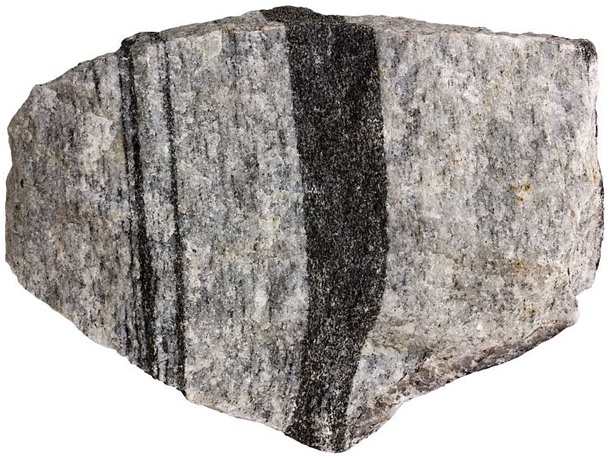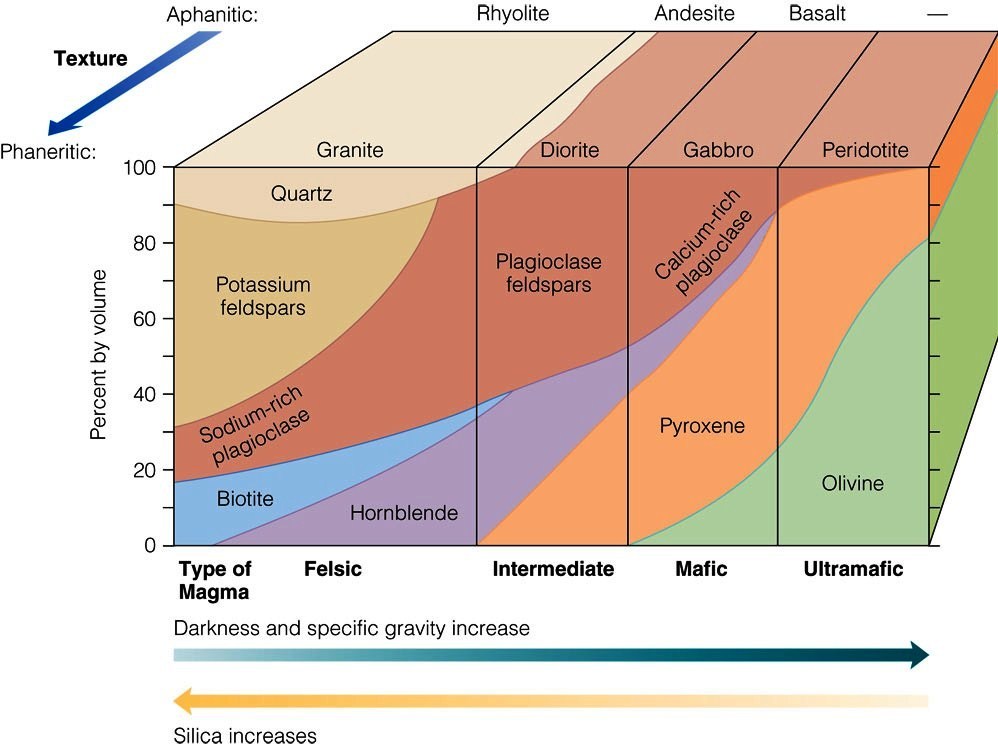
**This cache is located within an area frequently patrolled by Police. Please avoid acting suspiciously whilst searching for it, and if challenged, explain about geocaching. It may be worth pointing out that it is not a physical box you are looking for, but are simply studying the rocks visible to everyone.**
The learning point of this earthcache is to get the geocacher to become familiar with the Metamorphic rock Gneiss.
Metamorphic Rocks
Exposure to intense heat, pressure and chemical processes can result in the metamorphism of previously formed rocks, this is the way a metamorphic rock forms.

The word metamorphism comes from the word, morph which means transformed or changed. We can say that the metamorphic rocks are the “unlucky” rocks of the world because they got to their current state after being tortured by intense heat and pressure. So, metamorphic rocks are previously formed rocks that have been transformed by exposure to heat and/or pressure. This is the two influencing factors that can transform pre-existing rocks into metamorphic rocks. And as you can image, it takes very intense heat and pressure to make a rock change its form. In fact, the heat needed to make this change often comes from magma, which is the extremely hot fluid that forms below the surface of the Earth that is associated with volcanoes.
The pressure involved in metamorphism may come from the rock being deeply buried and this creates such intense pressure that crystals within the rock can grow together or collapse and rearrange into new mineral crystals. We also see that metamorphic rocks may be influenced by a third factor: the chemically active fluids that circulate around the newly forming rock and introduce different ions, which cause new and different mineral crystals to grow.
Every metamorphic rock has a parent rock! These parent rocks can be any type of rocks like igneous, sedimentary or even other metamorphic rocks. Knowing the parent rock can helps us classify these rocks, and we can further classify them by their texture.
Recrystallization, Neometamorphism, and Metasomatism
There are different metamorphic processes that are responsible for the changes that we see in these rocks. Recrystallization is most common and is defined as the metamorphic process by which crystals are packed together creating a new crystal structure. Recrystallization requires a lot of heat and pressure, and the process changes the mineral's size and shape, but the basic composition remains unchanged.
There are many examples of this like: limestone can go through the process of recrystallization to turn into marble. Limestone contains tiny calcite crystals that come from shells of marine creatures that were broken down and compacted into the sedimentary rock. When metamorphosed, those tiny crystals are slowly forced together under high pressure and begin to form larger, more visible crystals of calcite found in the metamorphic rock marble.
In other situations, mineral crystals may completely rearrange to form completely new minerals that are more stable under increased pressure and/or temperatures. This process is known as neometamorphism. This is most often observed with the sedimentary rock shale, which is composed of fine quartz, feldspars, and other clay minerals. When metamorphosed, these minerals will change to muscovite mica and garnet.
The process of metasomatism results in the loss or addition of chemicals. This can best be seen in the production of anthracite coal, which is almost pure carbon. The parent rock bituminous coal is produced from the aggregation of dead plant material, and anthracite is produced by the loss of the more volatile materials such as nitrogen, oxygen, and methane.

There are two basic types of metamorphic rocks.
Foliated metamorphic rocks such as gneiss, phyllite, schist, and slate have a layered or banded appearance that is produced by exposure to heat and directed pressure.
Non-foliated metamorphic rocks such as hornfels, marble, quartzite, and novaculite do not have a layered or banded appearance.
Gneiss
Gneiss is a very widespread type of rock, especially in the lower parts of the continental crust, and the stone is a very comman rock on the surface around Scandinavia.
Most of the crystals from the minerals in the gneiss are visible to the naked eye. Banding in this rock is a result of mineral segregation into separate, typically light- and dark-colored layers like you will be seeing at the coordinates. Light-colored layers are usually composed of feldspar and quartz. Most important dark minerals are hornblende and biotite.
Biotite and hornblende are two of the most common dark coloured minerals typically found in igneous rocks. Hornblende, it is typically masked by it’s strong green to green-brown colour. Biotite displays typical mica habit, the interference colours that would be seen are generally masked, though with only brown/black - not green.
Individual bands are usually 1-10 mm in thickness. If the layers are larger than that it can indicate a introduction of a new material that have probably taken place. Such rocks are called migmatites. It is often difficult to see the difference from migmatite because there is a gradational transition from one to another. Hence, terms like “migmatized gneiss” are commonly used. It is not well understood how the segregation takes place, but it must be the result of extreme pressure and shear stress deep in the crust.
The main sorce of gneiss may be or origin from an igneous rock, in this case it is called an orthogneiss for example. It forms probably because of shear in vicous granitic magma or the metamorphoms of a granite. Paragneiss is a variety with a sedimentary protolith. Even in the latter case, gneissic banding has nothing to do with original layering of sedimentary rocks. These original features are completely obliterated by the metamorphic processes involved in the formation of this rock type. Like described in the text above in the first part under the metamorphic information.
Paragneiss in most cases is thought to be the end product of metamorphism of a pelitic (clay-rich) sedimentary rock (shale, argillite, claystone, etc.) that metamorphosed first into slate, then became phyllite, schist, and finally gneiss. Still deeper burial or more intense heating may result in migmatization and finally complete melting of gneiss.
Despite being clearly oriented, this rock is not considered to be foliated because it is not fissile along the layering. So, when hammered, gneiss behaves like a uniform homogenous rock. In this sense it is similar to igneous rocks like granite and gabbro and not similar to related metamorphic rocks like schist and phyllite which are foliated.
It is important to note that gneiss is a rock type that is defined by its oriented texture, rather by its mineralogy or chemical composition. Hence, qualifying terms are often added to the rock name: amphibolite gneiss or hornblende gneiss, for example. The term “gneiss” without any additional information is commonly imagined to be compositionally similar to granite (K-feldspar, quartz, biotite).
Gneiss is a product of regional metamorphism. This is a type of metamorphism which is associated with mountain building. Gneisses form deep below the forming mountain ranges and are exhumed many millions of years later when the mountains get carried away by the erosion.

To log this cache.
To get to log this cache you will have to visit and answer the questions which are related to the coordinates given the earthcache.
When answers are collected, send them to CO for verification.
You can log immediately after answers are sent CO. If there are any questions about your answers CO will contact you.
Logs without answers to CO or with pending questions from CO will be deleted without any further notice.
Please do not include pictures in your log that may answer the questions.
Questions:
1. Answer the questions under by visiting the Coordinates.
A.Go to the coordinates and study the Gneiss closely. How big in mm are the crystals in the stone, and what closely related stone does this Metamorphic Rock origin from? Let me know how you conclude to get to your answer of the last part of the question?
B.1) What are the main colors in the stone? 2) And what are the minerals that makes them? 3) Study the columns and please conclude if you can observe the hornblende mineral. For this you will have to use a flash light to see if it shines of brown-ish dark (black) color, green or both!
C.As you can see the stone is foliated, but by studying it even more, can you say if it is a felsic, intermediate, mafic or ultramafic stone? (Use the diagram above).
2. (It’s voluntary to post a photo in your online log of your visit)
